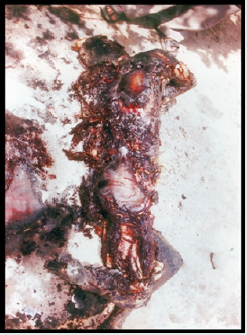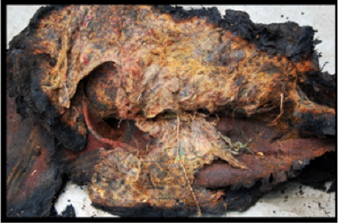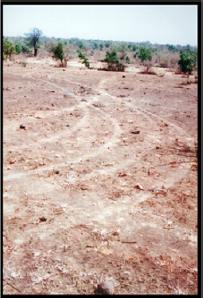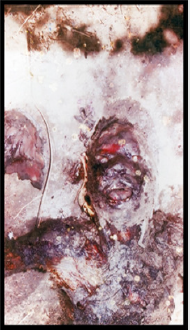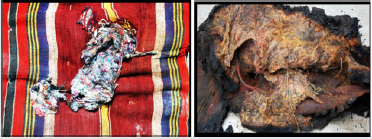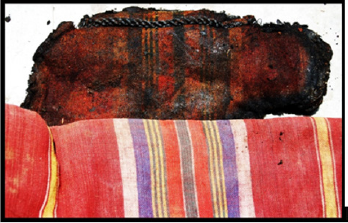
Lupine Publishers Group
Lupine Publishers
Menu
ISSN: 2638-6062
Case Report(ISSN: 2638-6062) 
The Destroyed Evidence Volume 4 - Issue 2
Rinkal Chaudhary1, Harsh Sharma2 and Vinod Dhingra3*
- 1Research Scholar, Amity School of Applied Sciences, Amity University Gurgaon, India
- 2Director, State Forensic Science Laboratory, Department of Home (Police), Government of Madhya Pradesh, India
- 3Senior Scientific Officer, Regional Forensic Science Laboratory, Department of Home (Police), Government of Madhya Pradesh, India
Received: September 16, 2020; Published: November 19, 2020
*Corresponding author: Vinod Dhingra, Senior Scientific Officer, Regional Forensic Science Laboratory, Department of Home (Police), Government of Madhya Pradesh, Gwalior, India
DOI: 10.32474/PRJFGS.2020.04.000184
Abstract
A series of investigation and examination of evidences is required to solve any criminal mystery. A crime scene investigator must be trained enough to observe crime scene and extract all crucial and relatable evidence with concurrently information of body identification, cause of death and sequence of events occurred. The investigation become more meticulous in the cases of burn, where identification of dead body is very challenging. Burns are the most devastating type of injury that one can bear and is equally devastating for relevant information that investigator can use to reconstitute the events of crime. A case was reported in Sukhi Sewania Police Station Bhopal MP, that a burned body was found in secluded place of forest near Amoni Village. The body was unidentifiable due to the severely burns and the only evidences collected from the crime scene were a piece of mattress, two empty canes with smell like petrol and mark of tyres from nearby soil in forest. This study highlights how investigators skillfully establish the link between two apparently different cases and solve the mystery by very limited silent clues. Finally, DNA test conclusively confirmed the identity of the victim.
Keywords: Burnt Body; Postmortem Burns; Physical Evidence; Destroyed Evidences
Introduction
Investigation of a crime is based on the physical evidences and information collected [1]. The revealing truth from physical evidences is much more reliable and authentic from other sources comparatively; like eye witnesses they can be manipulated [2]. A skilled forensic investigator while investing a crime scene collect any particular object that sense to be relatable to the crime and use it as a forensic evidence like weapon used for crime, pattern of bloodstain, position of body or bullet collected from the deceased and also use them to reconstruct the crime scene events, which in turn establish a link between crime and the criminal [3]. Meticulous investigation of crime scene and analysis of forensic evidences are often lead to success in solving the criminal mystery and due to the lack of these substantial physical evidences many cases remain unsolved [4,5]. However, the most particular investigation of crime for the recognition of evidences did not always leading to a clear interpretation of the cause of death [6]. In case of burns the important information like body identification, time & cause of death is challenging for the forensic investigator to find, due to condition of the body [7,8]. The forensic assessment of the burned bodies is difficult to establish the manner of death and the role of forensic pathologist is very crucial in revealing the cause of death whether it is accident, suicide or homicide [9]. A burned body has always been a hard task for forensic investigators in identification, time, cause, and manner of death [10,11]. The authors present a case of a unidentified burned body that was found in the forest of Amoni Village of Madhya Pradesh and the interpretation of that case was very difficult as not much substantial evidences was found on and near the spot.
Case History
An unrecognized burnt body was found near forest area of village Amoni. P. S. Sukhi Sewania on the outskirts of Bhopal MP. The recognition of the body was difficult as the burns are of 5th to 6th degree. No many evidences are also found on the crime scene and ante-mortem signs of burns were not present on the body of the deceased. The post-mortem sign of burns was enough evidence to describe that it was a case of homicide, which was confirmed by a thorough observation of signs and symptoms by forensic investigation team. The only evidences are collected from the scene of crime was a piece of burned mattress in which the body was probably wrapped, cloth piece from the body, two empty petrol canes and tyre marks of a vehicle on nearby soil surface. The details were noted i.e., distance between tyres, width and pattern of the tyre. Still the body remain unidentified and case remain unsolved due to lack of any lead in the case. The available details could not identify the deceased or provide any other lead and the case remained unsolved for about a year.
The spot was examined as per forensic requirements and observations are as below:
Forensic Expert Observations and Reconstruction of Scene of Crime
• The burnt body was of a male aged about 30 years and the
height was 5’7” (Figure 1).
• It was lying on a partially burnt cotton mattress (Figure
2).
• Two plastic containers smelling of petrol were recovered
from the spot.
• There were tyre marks of a vehicle near the body (Figure
3).
• The mouth was open and eyes popped out and burns
were postmortem in nature (Figure 4).
• The piece of mattress was found below the body containing
grey coloured waste cotton and hard traces of shining thread
which was usually used in tent houses and hieres (Figure 5).
• Relevant photographs were taken.
• The burns were about 5th to 6th degree and postmortem
in nature.
• The person had stained teeth and was habituated to use of
catechu (pan/gutka).
• The cause of death was not ascertained.
There was no lead in the case for about a year, the only progress
is that the tyre marks was possibly of TATA-407 make vehicle or its
derivatives, revealed on the basis of wheel dimension observation.
But this could not lead to body identification.
Investigation of the case and Turning point
Police officers during the investigation applied the several efforts to crack the case and finally they got a breakthrough and clue to this case, when an apparently different case of missing person from railway colony resolved by Government Railway Police, Bhopal. Suddenly, a turning point came. In this case a man named Rajesh Gupta was missing from railway colony. The father of missing person received ransom calls of Rs 1,00,000/- from his son’s mobile number, after which a complaint was filed. The mobile number details were investigated and on suspicious account a friend of missing person was found suspected and interrogated for the same. He disclosed that the missing person was dead and body was disposed off by burning in the forest near Amoni Village. The suspect revealed in the statement that he killed the missing person Mr. Rajesh Gupta while having a drink party, where an argument went between the two regarding money and he strangulate Rajesh to death during this. After this accused and his two friends booked a TATA-407 pick-up van vehicle, some mattresses and utensils were taken from a tent house purportedly for a picnic, they wrapped the Rajesh’s body in mattress and transport it to the forest near Amoni village and tried to burn the body by using petrol as a fuel for the destruction of evidences. This spot was same as of the case where burn body was recovered from Sukhi Sewania police. The deceased (Rajesh) friend mimic Rajesh’s voice and continue in touch with deceased father on calls with Rajesh’s number, so that he believed that his son is alive. But one day Sanjay asked for Rs 1,00,000/- from his father on call, which made him to register a complaint in police station regarding these ransom calls. The mattress piece of burn case evidence then matched with some mattresses (Figure 6,7) of the tent house stated by accused. The study of tyre marks was also confirmed by the accused statement. And further DNA testing confirms the body identification too. The location hooked the link between both the cases and DNA testing was performed which confirms that recovered burned body was of the missing person i.e. Mr. Rajesh Gupta. The investigating and police officers were able to establish the link between the two apparently different cases by matching the silent clues (cloth and cotton of the mattress). All the efforts to destroy the evidence thus failed and conclusively two apparently different cases were solved.
Conclusion
Physical evidences play a crucial role in investigation of any crimes. They work as silent witnesses. The case was solved on the basis of those physical evidences and even after so many efforts for the destruction of evidences, this case was finally solved by putting together the details of two different registered cases. The following points were notable
• The culprit thought that he could escape by burning
the body off in a secluded place and there by prevent the
identification of the victim and hence the cases would not be
solved.
• The piece of mattress found on the spot with body was
established to be from the tent house where the accused had
disclosed to have hired it by matching the type of grey coloured
waste cotton and the cloth fiber patterns with other mattresses
found in the tent house.
• The tyre marks found in the soil near the piece from
where the body was recovered was found matching with the
vehicle said to be used in the crime to transport the body-i.e.
TATA-407 pick-up van.
• Finally, DNA test conclusively confirmed the identity of
the victim as that of missing Rajesh Gupta.
Acknowledgement
Authors are thankful to Mr. Arvind Sharma, S.S.O, RFSL, Bhopal; Shri Jaideep Prasad, IPS, SP Bhopal Dr G. K. Pathak, S.R.P, Bhopal; Dr. C. S. Jain, Senior Forensic Expert, Medico-legal Institute, Bhopal; Mr. Vivek Asthana, S.H.O, Sukhi Sewania Police Station, Bhopal; Smt. Sarika Pandey, S.I, GRP Police Station Bhopal, MP, India for providing necessary facilities and help.
References
- Lee, Henry C, Elaine M, Pagliaro (2013) Forensic evidence and crime scene investigation.Journal of Forensic Investigation 1(2) : 1-5.
- Lee, Henry C, Palmbach TM (2006) Crime Scene Management. (In): In Forensic Science and Law (eds). Cyril Wecht and John Rago CRC Press, Boca Raton, FL pp. 577-593.
- Focardi M, Defraia B, Bugelli V, (2019) An Unusual Case of Postmortem Burning Following Suicide. 10:1.
- Joseph L Peterson, John P Ryan, Pauline J (1986) Forensic Science and the Courts (In): The Uses and Effects of Scientific Evidence in Criminal Case Processing. (eds). Washington DC, NCJRS Reports Department of Justice, USA
- Truman JL, Planty M (2012) Criminal Victimization in the United States, 2011. Bureau of Justice Statistics Office of Justice Programs, Washington, DC.
- Gerling I, Meissner C, Reiter A, Oehmichen M (2001) Death from thermal effects and burns. 115: 33-41.
- Bassed R (2003) Identification of severely incinerated human remains: the need for a cooperative approach between forensic specialities. 43: 356-361.
- Matoso RI, Benedicto EN, DeLima SH, Prado FB, Daruge E, et al. (2013) Positive identification of a burned body using an implanted orthopedic plate. 229: 168 -168.
- Eckert WG, James S, Katchis S (1988) Investigation of cremation and severely burned bodies. 9(3): 188-200.
- Tumer AR, Akçan R, Karacaoğlu E, Balseven Odabaşı A, Keten A (2012) Postmortem burning of the corpses following homicide. 19(4): 223-228.
- Bohnert Michael, Christoph R Werner, Stefan Pollak (2003) Problems associated with the diagnosis of vitality in burned bodies. Forensic science international 135(3): 197-205.

Top Editors
-

Mark E Smith
Bio chemistry
University of Texas Medical Branch, USA -

Lawrence A Presley
Department of Criminal Justice
Liberty University, USA -

Thomas W Miller
Department of Psychiatry
University of Kentucky, USA -

Gjumrakch Aliev
Department of Medicine
Gally International Biomedical Research & Consulting LLC, USA -

Christopher Bryant
Department of Urbanisation and Agricultural
Montreal university, USA -

Robert William Frare
Oral & Maxillofacial Pathology
New York University, USA -

Rudolph Modesto Navari
Gastroenterology and Hepatology
University of Alabama, UK -

Andrew Hague
Department of Medicine
Universities of Bradford, UK -

George Gregory Buttigieg
Maltese College of Obstetrics and Gynaecology, Europe -

Chen-Hsiung Yeh
Oncology
Circulogene Theranostics, England -
.png)
Emilio Bucio-Carrillo
Radiation Chemistry
National University of Mexico, USA -
.jpg)
Casey J Grenier
Analytical Chemistry
Wentworth Institute of Technology, USA -
Hany Atalah
Minimally Invasive Surgery
Mercer University school of Medicine, USA -

Abu-Hussein Muhamad
Pediatric Dentistry
University of Athens , Greece

The annual scholar awards from Lupine Publishers honor a selected number Read More...




